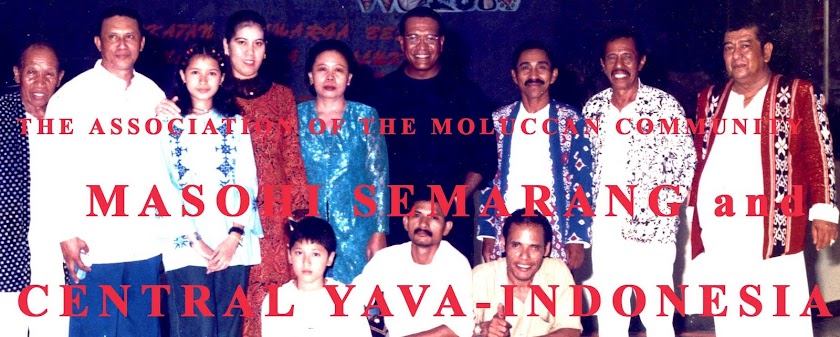AMBON - The name of the island Ambon is believed to come from the word apon, meaning "plantation'. Indeed, Ambon was one of the firsts Moluccan islands to be occupied by the Portuguese and used as a plantation. Ambon City is the Main City and seaport of Ambon Island, and is the capital of Maluku Province. It is one of the largest cities in eastern Indonesia.
Ambon, the provincial capital of Maluku, which is built on a hillside overlooking the bay, has a number of interesting sites of historical and cultural interests. Among them are the remnants of some old forts built by the Dutch East Indies Company during the heydays of the spice trade and the Siwa Lima Museum with its local arts and crafts collection. More ruins of forts are found such as the Dutch one at Lima and those of the Portuguese at Hila, which are almost entirely hidden underneath the contorted roots of a giant Banyan tree.
The ANZAC War Cemetery near Ambon town is the site of services held every year to commemorate the Allied soldiers who died in the region during world War 11. Ambon is at Maluku end of the annual yacht race between Darwin, Australia and Ambon. The race usually takes place in August.
Ambon, as a beautiful city, has a lot of tourism objects that offer the tourist much beautiful scenery. On arrival in AMBON, you will be met at Pattimura airport, transfer to your hotel. After lunch, visit WAISELAKA POND in WAAI, its clear crystal water inhabited by holy eel, The Crazy Bamboo Performance. You can have dinner and overnight at your hotel.
BANDA ISLAND - The Banda group, about 160 kilometers southeast of Ambon, consists of three larger islands and seven smaller ones, perched on the rim of Indonesia's deepest sea, the Banda Sea. Near Manuk Island, the water reaches more than 6,500 meters depth. Of the three biggest islands Banda, Banda-Neira and Mount Api, the first two are covered with nutmeg trees and other vegetation. The third however, is entirely bare and highly volcanic. The last eruption of Mt. Api occurred only a few years ago. The seas around Banda are the sites of the famous Maluku sea gardens with their bright corals and colorful fish darting through the crystal-clear waters. Facilities for sightseeing, snorkeling and skin-diving are available, as well as clean, comfortable cottages.
Banda saw some of the bloodiest episodes of Maluku's past history during the 17th century. In 1609, the Dutch East Indies Company (VOC) dispatched Verhoeff to the islands to obtain the contested spice trade monopoly at any cost. Confronted by a superior power, people Banda were forced to allow the company to establish a fort, but in that same year Verhoeff was killed together with 45 of his men. The Company retaliated, but peace was not restored. In 1619, V.O.C. Governor-General Jan Pieterszoon Coen arrived at the head of a penal expedition and exterminated the entire population of Banda. The land was divided into lots, called "perken”, and given to former company employees, the "perkiniers", who were obliged to grow nutmeg and sell them at predetermined prices to the company. Slaves did the actual work in the fields. The old "perkenier houses", or what is left of them, and old churches still retain a peculiar colonial character to the port town of Bandaneira today. Two old forts Belgica and Nassau are inside the town limits. Others are found elsewhere on the islands. See also the former Dutch Governor's mansion, the History Museum in Neira, and the huge nutmeg plantation nearby.
Lelisa Beach - The beach that across to Namalatu Beach is has coral form till the beach. If see the beach when it has ebb, it will present a beautiful nature scenery that cannot enjoyed in other beach. This beach has become the icon for they who like to Snorkeling, diving, swimming and sunbathing.
Batu Capeo - There is coral stone that has cap form in this tourism object. The interesting point is the beautiful scenery when it is sunrise.
Siwalima Museum - This museum was built in 8 September 1973. The collections in this museum are the historic objects of Maluku. This location is often used to hold a Maluku culture attraction such as, arts, crafting, etc. If the tourists want to get Maluku souvenirs, they can get it, because there are many sellers who sell souvenirs.
Tanjung - The location with 400 meters width has a lot of coconut trees and corals with beautiful scenery in front of the Banda Sea. This Beach has many corals and fast water flow.
Santai Beach - This tourism object is located in Latulahat village. The panorama in this beach that has white sand is so beautiful and has been visited by many visitors. Usually, they have swimming, sunbathing or walking arround.
Felawatu Beach - Felawatu Beach is located in Airlouw village, or about 15 km from the downtown. The visitors will feel forbear to stay in this beach, because it has beautiful panorama and soft wind. It also has coconut tree that very green and fresh.
Pintu Kota - Pintu Kota is a big coral that looks like a gate and stay at Banda Sea. This tourism object is located in Airlaow village and Seri Village. The uniquely of this is the specific coral form.
Gotong Royong Market in the harbor area is slowly being replaced by sanitized setting of a newly built Merdeka market. Shopping along Patty Street of the market, look for framed montages from shaped pieces of mother of pearl, 'ikat' cloth from Taimbar and miniature ships cleverly made from wire and cloves. At the end of Patty Street, there is the Al Fatah Mosque.
SERAM ISLAND - Seram, the largest and among the least known islands in Maluku, hovers over Ambon, Saparua and lots of sea. Many of Ambon's tradition are said to have originated from Seram, including the division into two sets of customs, patasiwa and patalima, as well as pela alliances between two villages often located far apart. Seram is also replete with magic, for the Amboneses anyway, with many anecdotes of men who can fly, kill at a distance and change their shape at will. While the western part of the island has lost its mystery, thanks to thriving lumber industry, the remote eastern mountains is where the magic is now concentrated.
MASOHI - Masohi the capital of the central Maluku district is on Seram's south-central beach. The plains around the town have received a population boost, with migrant from overcrowded Saparua and some of the isolated islands to the south, as well as resettled mountain dwellers from Seram itself. One group of mountain people, the Naulu with their familiar red headbands live fairly close to Masohi.
MOUNT API - Mount Api, active Volcano Island directly opposite Banda Neira last erupted in the late 1980s but fortunately almost all the lava and ash fell on the side away from the town. The view from the summit is spectacular. To climb, go with a guide and get start early to beat the heat of the day. Count on 20 - 30,000 for a guide, including the canoe ride to and from Banda Neira. A guide isn't really necessary since once you land on the dock on the East Side of Mount Api, there's only one way up and it's pretty obvious. If you're alone and safety conscious, you may wish to take a guide since the trail is quite treacherous.
TUAL - Tual is the capital of Southeast Maluku district and the transportation for an extensive network of roads and sea-lanes. A half an hour drive away is Dullah village, where Belaway Museum boasts a splendid ceremonial conoe, complete with carved decorations. From Tual, canoes depart daily to the mysterious island of Kei Besar. Occasionally, the boats from Tual also head for Dobo, the largest town of the Aru archipelago. This spread of some 25 islands, all mangrove swamp and low-lying palm forest, is the home of unusual butterflies and flocks of birds-of-paradise.
























0 komentar:
Post a Comment